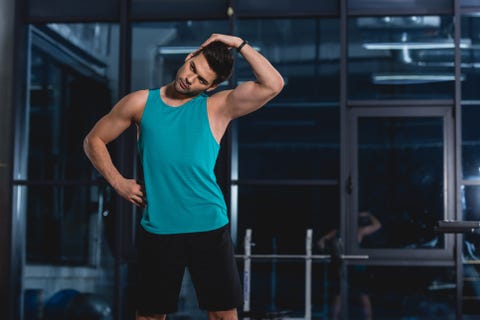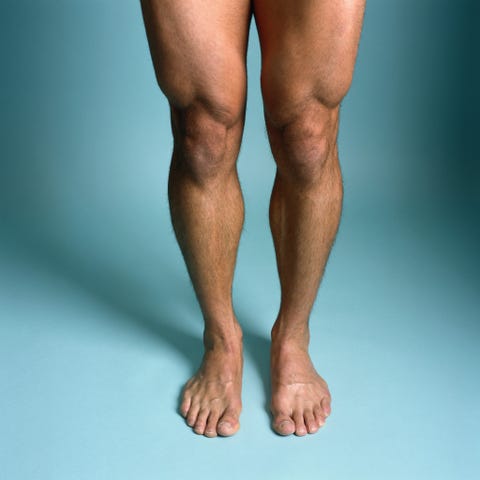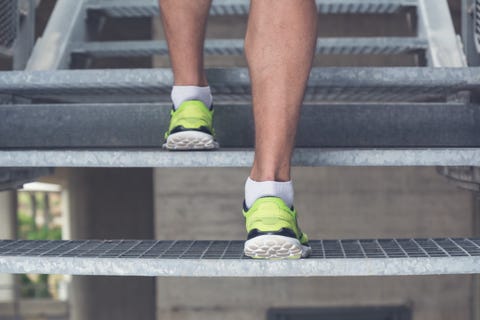

You think you’re on top of your workout game. You’re always in the gym, you mix up your muscle groups — hell, you even make cardio a priority. But when was the last time you worked your deep cervical flexors?
Before you Google where those muscles are, let’s assume you haven’t made time for them in your regular workout routine. But that’s about to change.
Many men apply the “bigger is better” philosophy to working out. But some of the most important muscles in daily life require the least equipment to strengthen. While you’re focusing on the muscles you can see — the lats, pecs, biceps, rectus abdominis, glutes and quads — the muscles that actually help you get things done are being left out. These areas need your attention, too — or you might even face problems down the line.
Here is a list of 5 muscles (or muscle groups) that you’ll want to work into your regular fitness routine, starting now:
1. Deep cervical flexors.

Getty ImagesLightFieldStudios
Chances are you’ve never thought about these muscles in your life, but they are crucial for proper head positioning.
Deep cervical flexors include the Longus Colli and Longus Capitis, which play an important role in stabilizing the neck and improving your head position and cervical alignment. These muscles are often weak in people who spend many hours at a computer or at a desk, leading to a forward head position or the chin being tilted upwards.
Research shows that strengthening the deep cervical flexors can reduce symptoms in people living with chronic neck pain. Unsure if your neck is weak? Try lying flat on your back. Tuck your chin downward then lift the head up using only your neck. Try and hold this position for 20 seconds. Not so easy, huh? Weakness in these muscles can lead to cervical and thoracic pain, and even headaches.
Try a chin tuck to strengthen these muscles, and try incorporating your new and improved alignment into your lifting routine.
2. Grip strength

Getty ImagesMel Curtis
We use our hands for countless tasks every day, but how often do you take time t0 specifically strengthen your grip? Unless you’re a rock climber or training for the next American Ninja Warrior competition, the answer is probably not often enough.
Research shows that grip strength might be an early indicator of long-term health and longevity. In fact, it may also be a predictor of disease risk in the future. On top of that, your hands are the connection to those heavyweights you’re lifting at the gym. Make an extra point to ensure those hands are strong, and you’ll only see positive results.
If you’re already doing some heavy lifting, strengthen your grip by performing these exercises. Or if you’re just starting out, try low-resistance wrist extension/flexion with a dumbbell, squeezing a soft ball with your hand, or practicing pinch gripping heavy weights to target some important muscles in the fingers.
3. Intrinsic foot muscles

Getty ImagesAnthony Saint James
Our feet connect us with the world. Most of the time, they are our only physical connection, so what happens down there matters. Intrinsic foot muscles are the muscles that start and end in the foot itself. We don’t use our feet for climbing and traversing rocks and sticks like we used to back in prehistoric times, so the role of our feet in daily life has been minimized. But that doesn’t mean we don’t need them to be strong.
Arch support comes from a team of muscles, including the intrinsic foot muscles. By strengthening these muscles, you can help prevent your arches from collapsing. Why does this matter? When those arches collapse, your feet pronate. This can contribute to valgus at the knee (or the knees knocking together or moving inward inward). This stresses the inner knee compartment. Compound the force created by that movement with heavy lifting, single leg leaping and jumping, and you put your knees at high risk for injury.
Try practicing foot doming while you lift to train your feet stay in better alignment. Your knees will thank you.
4. Transverse abdominis

Getty Imagesglobalmoments
When people think of the “core” they often imagine the rectus abdominis (RA) muscle, or the muscle that gives you a six pack. But the transverse abdominis (TA) is often left out of training.
If you’ve ever seen a low back brace when someone is lifting at the gym, you should have an idea of the purpose of this muscle. The TA is deeper than the RA and wraps around the lower abdomen and upper pelvis to form your very own built-in low back brace.
The first step is figuring out how to engage this muscles. Once you practice some gentle activation and strength exercises, the TA should be engaged for stability prior to any lifting.
5. Lateral ankle stabilizers (peroneals and tibialis posterior)

Getty Imageszoff-photo
If you’ve got wobbly ankles, the more weight you load onto your body the more prone to injury you become. The peroneus longus and peroneus brevis wrap around the outer (lateral) ankle and move your ankle to the side while helping dorsiflex the ankle (lift the toes up — important for not tripping and avoiding turf toe). The tibialis posterior is on the other side of your ankle, wrapping around the inner (medial) ankle and helping to both move your ankle inward and point your toe downward.
But most of the time, these muscles are working together to stabilize your ankle. They are part of an important group that helps to prevent excessive ankle movement during single and double leg activities. To work on ankle stability, try single leg exercises such as standing on one leg and moving the other leg forward, sideways and backwards ten times. If that’s easy, try doing it while balancing on an unstable surface like a pillow or a BOSU.
Look back at this list. If you’re lifting heavy with bad head positioning, weak grip strength, turned in knees, and no built-in low back brace, you might be putting yourself at risk for an injury.
Save yourself the setback by focusing on those little muscles you never thought about before. You could even wind up becoming the guy with the strongest cervical flexors in the gym. You’ll only see positive results from putting in the extra work, so start focusing on the little things to make the big things even better.
Source: Read Full Article